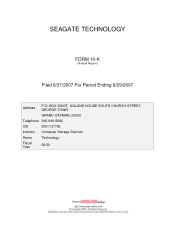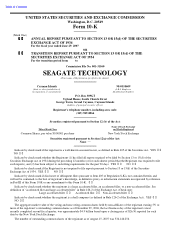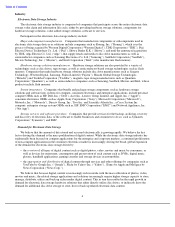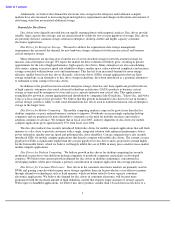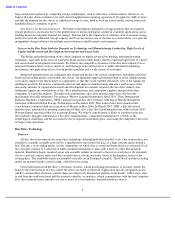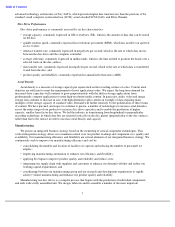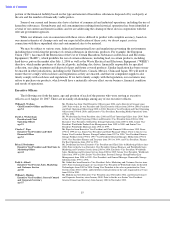Seagate 2006 Annual Report Download - page 8
Download and view the complete annual report
Please find page 8 of the 2006 Seagate annual report below. You can navigate through the pages in the report by either clicking on the pages listed below, or by using the keyword search tool below to find specific information within the annual report.
Table of Contents
Additionally, we believe that demand for electronic data storage in the enterprise and traditional compute
markets have also increased as increasing legal and regulatory requirements and changes in the nature and amount of
data being stored has necessitated additional storage.
Demand for Disc Drives
Disc drives store digitally encoded data on rapidly rotating platters with magnetic surfaces. Disc drives provide
reliable, large capacity data storage, and are characterized by relatively low-cost per gigabyte of storage. Disc drives
are presently the most common storage solution in enterprise, desktop, mobile and higher capacity consumer
electronics applications.
Disc Drives for Enterprise Storage. The need to address the expansion in data storage management
requirements has increased the demand for new hardware storage solutions for both mission critical and business
critical enterprise storage.
Many enterprises are moving away from the use of server-attached storage to network-attached storage for
mission critical enterprise storage. We expect the market for these solutions will likely grow, resulting in greater
opportunities for the sale of high-performance, high capacity disc drives. Many enterprises are also consolidating
data centers, aiming to increase speed and reliability within a smaller space, reduce network complexity and increase
savings associated with hardware costs and maintenance. This has led to an increased demand for more energy
efficient, smaller form factor disc drives. Recently, solid state drives (SSDs) storage applications that use flash
storage technology as an alternative to disc drive storage technology, have been introduced as a potential alternative
to redundant system startup or boot disc drives.
In addition to the growth in mission critical enterprise storage, there has also been significant growth in the use
of high capacity, enterprise class serial advanced technology architecture (SATA) products in business critical
storage systems used by enterprises to store and access capacity-intensive non-critical data. This application is
exemplified by growth in content aggregation and distribution by companies like Google Inc., Yahoo! Inc. and News
Corp as well as storage service providers. We believe that this growth in demand for disc drives for use in business
critical storage systems is likely to shift some demand from disc drives used in traditional mission critical enterprise
storage in the longer term.
Disc Drives for Mobile Computing. The mobile computing market is expected to grow faster than that for
desktop computers as price and performance continue to improve. Notebooks are increasingly replacing desktop
computers and are progressively more desirable to consumers as the need for mobility increases and wireless
adoption continues to advance. We estimate that in fiscal year 2007, industry shipments of disc drives for mobile
compute applications grew approximately 35% from fiscal year 2006.
The disc drive industry has recently introduced hybrid disc drives for mobile compute applications that add flash
memory to a disc drive to provide customers with a single, integrated solution with enhanced performance, better
power utilization, quicker start-up speed and prolonged disc drive durability. Certain companies have also recently
introduced SSDs for mobile compute applications that directly compete with mobile disc drives. The current cost per
gigabyte for SSDs is significantly higher than the cost per gigabyte for disc drives and is projected to remain higher
for the foreseeable future, which we believe will largely inhibit the use of SSDs in many price-sensitive mass-market
mobile compute applications.
Disc Drives for Desktop Computing. We believe growth in disc drives for desktop computing has recently
moderated, in part due to the shift from desktop computers to notebook computers, particularly in developed
countries. We believe that current growth in demand for disc drives in desktop computing is concentrated in
developing markets where price remains a primary consideration in compute application data storage purchases.
Disc Drives for Consumer Electronics. Disc drives in the consumer electronics markets are primarily used in
DVRs and gaming consoles which require more storage capability than can be provided in a cost-effective manner
through alternative technologies such as flash memory, which are better suited to lower capacity consumer
electronics applications. We believe the demand for disc drives in consumer electronics will become more
pronounced with the increased amount of high definition content that requires larger amounts of storage capacity.
With respect to handheld applications, we believe disc drive products smaller than 1.8-inch form factors have to a
5

